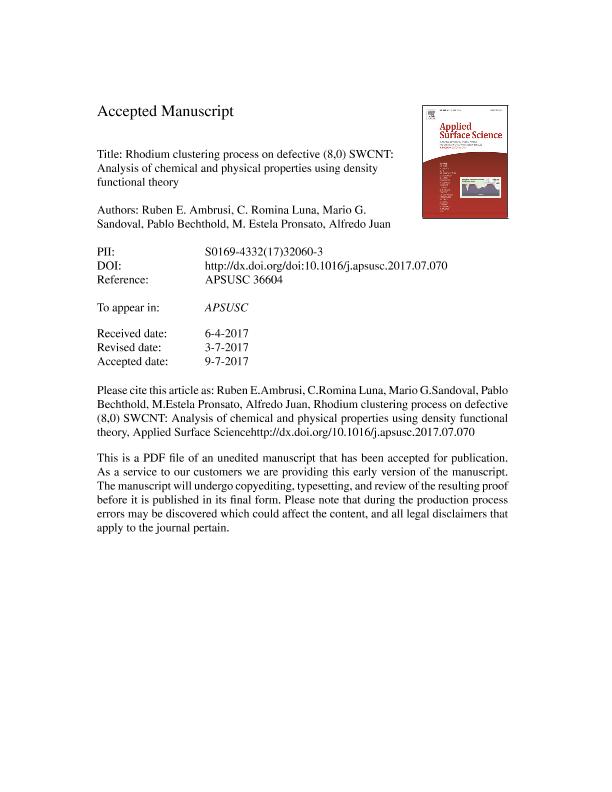Artículo
Rhodium clustering process on defective (8,0) SWCNT: Analysis of chemical and physical properties using density functional theory
Ambrusi, Rubén Eduardo ; Luna, Carla Romina
; Luna, Carla Romina ; Sandoval, Mario German
; Sandoval, Mario German ; Bechthold, Pablo Ignacio
; Bechthold, Pablo Ignacio ; Pronsato, Maria Estela
; Pronsato, Maria Estela ; Juan, Alfredo
; Juan, Alfredo
 ; Luna, Carla Romina
; Luna, Carla Romina ; Sandoval, Mario German
; Sandoval, Mario German ; Bechthold, Pablo Ignacio
; Bechthold, Pablo Ignacio ; Pronsato, Maria Estela
; Pronsato, Maria Estela ; Juan, Alfredo
; Juan, Alfredo
Fecha de publicación:
12/2017
Editorial:
Elsevier Science
Revista:
Applied Surface Science
ISSN:
0169-4332
Idioma:
Inglés
Tipo de recurso:
Artículo publicado
Clasificación temática:
Resumen
The Spin-polarized density functional theory is used to study the effect of a single vacancy in a (8,0) single-walled carbon nanotube (SWCNT) on the Rh clustering process. The vacancy is considered oxygenated and non-oxygenated and, in each case, different Rhn cluster sizes (n = 1–4) are taken into account. For the analysis of these systems some physical and chemical properties are calculated, such as binding energy (Eb), work function (WF), magnetic moment, charge transfer, bond length, band gap (Eg), and density of state (DOS). From this analysis it can be concluded that: a single Rh atom and Rh2 dimer are adsorbed on vacancy without oxygen, whereas Rh3 and Rh4 clusters prefer to be adsorbed on oxygenated vacancy. In all cases, Rh adsorption induces a magnetic moment. When the Rh atom and Rh2 dimer are bonded to the defective SWCNT, it has been found that they show a semiconductor behavior that could be interesting to use in the spintronic area. In the case of Rh3 and Rh4 clusters our results show a metallic behavior suggesting that these systems are good candidates for nanotube contact.
Palabras clave:
Adsorption
,
Cnt
,
Dft
,
Vacancy
Archivos asociados
Licencia
Identificadores
Colecciones
Articulos(IFISUR)
Articulos de INSTITUTO DE FISICA DEL SUR
Articulos de INSTITUTO DE FISICA DEL SUR
Citación
Ambrusi, Rubén Eduardo; Luna, Carla Romina; Sandoval, Mario German; Bechthold, Pablo Ignacio; Pronsato, Maria Estela; et al.; Rhodium clustering process on defective (8,0) SWCNT: Analysis of chemical and physical properties using density functional theory; Elsevier Science; Applied Surface Science; 425; 12-2017; 823-832
Compartir
Altmétricas



